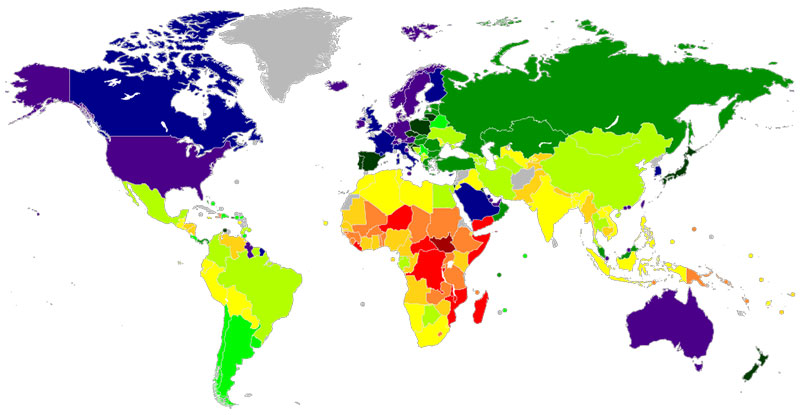Competing in a Changing World

In economics, annual Gross Domestic Product (GDP) is the total monetary value of all final goods and services produced within a country's borders over a year. It serves as an indicator of a nation's economic performance and size. GDP (PPP) is the Gross Domestic Product based on Purchasing Power Parity (PPP). PPP adjusts GDP for the relative cost of local goods, services, and inflation rates for each country, which makes it a much more useful and realistic calculation than using exchange rate calculations for a theoretical international dollar. Several international organizations calculate GDP—The International Monetary Fund, The World Bank, and CIA—and arrive at slightly different figures. The World Bank and IMF figures are generally close. CIA estimates may be politicized. The statistics presented here are from the International Monetary Fund (IMF) based in Washington. The United States is used as the comparison standard so the GDP and GDP (PPP) for the United States are the same. These are the most recent estimates for calendar year 2025.
| Country | GDP (PPP) | GDP (nominal) | Per Capita GDP (PPP) |
| 1) China | $40.7 trillion | $19.2 trillion | $28,978 |
| 2) United States | $30.5 trillion | $30.5 trillion | $89,165 |
| 3) India | $17.6 trillion | $ 4.2 trillion | $12,132 |
| 4) Russia | $ 7.2 trillion | $ 2.1 trillion | $49,383 |
| 5) Japan | $ 6.7 trillion | $ 4.2 trillion | $54,677 |
| 6) Germany | $ 6.2 trillion | $ 4.7 trillion | $72,599 |
| 7) Indonesia | $ 5.0 trillion | $ 1.4 trillion | $17,012 |
| 8) Brazil | $ 5.0 trillion | $ 2.1 trillion | $23,239 |
| 9) France | $ 4.5 trillion | $ 3.2 trillion | $65,626 |
| 10) United Kingdom | $ 4.4 trillion | $ 3.8 trillion | $63,601 |
| 11) Italy | $ 3.7 trillion | $ 2.4 trillion | $63,076 |
| 12) Turkey | $ 3.7 trillion | $ 1.4 trillion | $42.45 |
| 13) Mexico | $ 3.4 trillion | $ 1.7 trillion | $25,463 |
| 14) South Korea | $ 3.4 trillion | $ 1.8 trillion | $65,112 |
| 15) Spain | $ 2.8 trillion | $1.8 trillion | $56,555 |
| 16) Canada | $ 2.7 trillion | $ 2.2 trillion | $65,707 |
| 17) Egypt | $ 2.4 trillion | $ 347 billion | $21,668 |
| 18) Saudi Arabia | $ 2.2 trillion | $ 2.1 trillion | $61,923 |
| 19) Poland | $ 2.0 trillion | $ 980 billion | $55,186 |
| 20) Australia | $ 2.0 trillion | $ 1.8 trillion | $72,138 |
Here are four other countries listed as the top 20 GDP (nominal) nations in 2025 in last week’s study of the GDP to Debt. I have also added South Africa, since it is a founding member of BRICS (Brazil, Russia, India, China, South Africa):
| GDP (PPP) rank | |||
| 28) Netherlands | $ 1.5 trillion | $ 1.3 trillion | $84,566 |
| 29) Argentina | $ 1.5 trillion | $ 601 billion | $31,380 |
| 33) South Africa | $ 1.0 trillion | $ 418 billion | $6,520 |
| 34) Singapore | $ 953 billion | $ 496 billion | $156,758 |
| 39) Switzerland | $881 billion | $ 947 billion | $97,581 |
Wikipedia lists Singapore as first in the world in GDP (PPP) per capita. Luxembourg is second with $152,197; Ireland is third with $134,000; Qatar is fourth with $121,605; Norway is fifth with $107,892; Switzerland is sixth; the United States is ninth, Denmark tenth with $88,934. The Netherlands is eleventh.
There are intriguing stories imbedded in many of these statistics. For Example, the Republic of Ireland has a small population of about 5.4 million and a GDP (PPP) of $737 billion, which gives them the third highest GDP (PPP) per capita ($134,000) in the world. They are in the top ten in the world for Gross National Income (GNI) per person Ireland has an open economy and ranks first in high-value Foreign Direct Investment (FDI) flows. It has been named the best country in the world for Foreign Direct Investment at least six times. Foreign multinational corporations are the main engine of Ireland’s economy, employing about 25 percent of the private sector workforce and paying 80 percent of Irish corporate taxes. Ireland is one of five countries with corporate tax rates below 15 percent, and most corporations pay only 12.5 percent. Fourteen of Ireland’s 20 largest multinational corporations are American based, and 80 percent of foreign multinationals are Americans. Only 77 percent of Ireland’s population identify as “white Irish.” About 11 percent are “other white.” About 6 percent do not claim any ethnic identity. About half the remaining 6 percent identify as Asian. About 76 percent of the population identify as Christian, and about 69 percent identify specifically as Catholic. Ireland is one of 27 members of the European Union. The UK and thus Northern Ireland are not members, nor are top-ten PPP per capita nations Norway and Switzerland.
There are many other interesting stories in these statistics. The large difference between Russia’s GDP and more realistic and higher GDP (PPP) partly explains how the US and NATO badly underestimated Russia’s ability to resist economic sanctions and its ability to mobilize industrial and war materials production by several times that of the US and NATO combined. Russia’s rapid rise in economic prosperity and per capita standard of living since 2000 also explains why Putin’s favorability ratings among the Russian people are usually over 80 percent, making NATO plans for regime change an absurd delusion.
China’s population in 2025 is estimated at 1.416 billion. That is over four times the estimate of 347 million for the United States in 2025. Moreover, the Chinese are an intelligent people and China ranks second only to Singapore in World PISA educational test scores. The US tested well but in seventeenth place. Besides Singapore and China, the top ten PISA testers were Japan, Taiwan, South Korea, Hong Kong, Estonia, Canada, Ireland, and Switzerland. With such a large population and high educational testing achievement, it is inevitable that China’s lead in GDP (PPP) will increase. We should also expect their per capita GDP (PPP) to increase dramatically. The same is also likely for India. The US needs to reform its immigration system, concentrating on strict control of a predominantly merit-based system.
Americans typically have little interest in the world outside our own borders. This has led to political attitudes that do not serve our own people well. It ignores both good and bad examples that teach us important lessons for progress and warn us of unproductive efforts, pain, and failure. It is good to be proud of your country but uninformed or ignorant pride most often leads us to self-righteous, arrogant hubris. In business and economic planning this frequently leads to underestimating the competitive environment or competition and overestimating our own resources and abilities. In war and national defense, underestimating potential adversaries and delusional confidence in our own superiority are sure ways to military and foreign policy disaster.
“The pessimist complains about the wind; the optimist expects them to change; the realist adjusts his sails.”—William Arthur Ward









 Mike Scruggs is the author of two books: The Un-Civil War: Shattering the Historical Myths; and Lessons from the Vietnam War: Truths the Media Never Told You, and over 600 articles on military history, national security, intelligent design, genealogical genetics, immigration, current political affairs, Islam, and the Middle East.
Mike Scruggs is the author of two books: The Un-Civil War: Shattering the Historical Myths; and Lessons from the Vietnam War: Truths the Media Never Told You, and over 600 articles on military history, national security, intelligent design, genealogical genetics, immigration, current political affairs, Islam, and the Middle East. 


